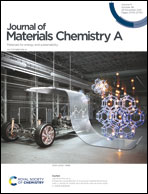Precursor solution-dependent secondary phase defects in CsPbBr3 single crystal grown by inverse temperature crystallization†
Abstract
The understanding and tailoring of crystalline defects have been important factors in the technological deployment of established semiconductors. Here, we report the secondary phase (SP) defects of CsPb2Br5 in CsPbBr3 crystals grown by inverse temperature crystallization. The micron-scale SP defects are found to possess a well-defined polyhedral morphology, illustrated by the 14-hedron model. A heterogeneous nucleation mechanism of SP defects on the step-like surface of CsPbBr3 associated with the deviation of the chemical state of the precursor solution is proposed. The spatial inhomogeneity distribution of SP defects is highlighted along the CsPbBr3 crystal growth direction. The SP defects area density at the subsurface is about 6.3%, but it exponentially decreases to 0.51% after thinning for 0.2 mm. Correspondingly, the hole mobility increases from 41.79 to 74.54 cm−2 V−1 s−1. Moreover the infrared transmittance, bulk resistivity and photoresponse ON/OFF ratio are significantly elevated. We emphasize that the lattice distortion region in the near-surface induced by the high density of SP defects severely deteriorates carrier transport due to the formed trapping centers, interface transport barrier and intrinsically poor transmission along the c axis. Therefore, understanding and eliminating SP defects is a preferred alternative for achieving high-performance CsPbBr3-based optoelectronic devices.



 Please wait while we load your content...
Please wait while we load your content...